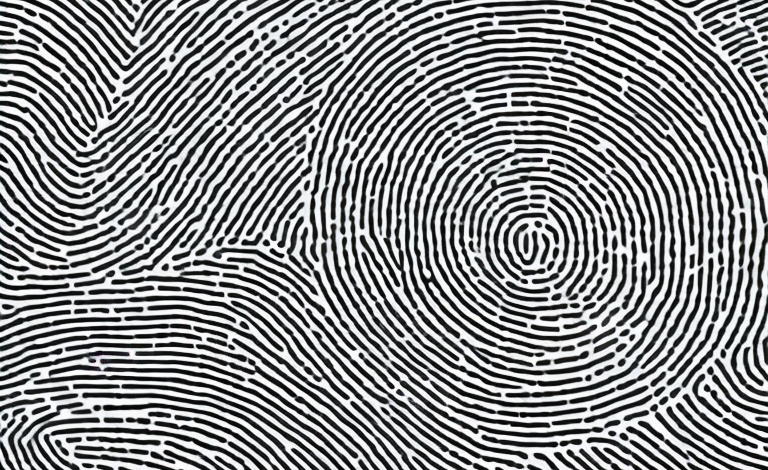Fingerprints have been used as a means of identification for over a century. But among the many types of fingerprints, the double loop fingerprint stands out as one of the most unique and fascinating patterns. In this article, we will explore the science behind fingerprints and delve deeper into the world of double loop fingerprints to answer the question, “How rare is a double loop fingerprint?”
Understanding fingerprints – A brief introduction
To begin, let’s first understand what fingerprints are. Simply put, fingerprints are patterns of ridges and valleys on the skin of our fingertips. These patterns are unique to each individual, making them an excellent means of identification. The study of fingerprints is known as dactyloscopy.
What is a double loop fingerprint?
A double loop fingerprint is a distinctive pattern that is created by two separate loop formations that flow in opposite directions. This results in a pattern that looks like two intertwined loops. Double loop fingerprints are one of the more complex types of fingerprints and are less common than other patterns.
Double loop fingerprints are often found on the fingers of individuals who have a genetic predisposition for this pattern. They can also be caused by certain medical conditions or injuries to the fingers. Despite their complexity, double loop fingerprints can still be used for identification purposes, as they are unique to each individual and can be compared to a database of known prints.
The science behind fingerprint analysis
Fingerprint analysis involves the study of the patterns and ridges on a fingerprint to identify an individual. The science behind fingerprint analysis is based on the fact that every person’s fingerprints are unique and do not change over time. This makes them an excellent tool for forensic investigations and criminal justice cases.
There are three main types of fingerprints: arches, loops, and whorls. Arches are the least common and have a simple, upward curve. Loops are the most common and have a recurving ridge pattern that enters and exits from the same side. Whorls have a circular or spiral pattern and are the second most common type of fingerprint. By analyzing the type of fingerprint and the specific ridge characteristics, forensic experts can determine the likelihood of a match between a suspect and a crime scene.
How are fingerprints formed?
Fingerprints are formed while we are still in the womb and are influenced by various factors such as genetics, pressure, and amniotic fluid. As we continue to grow, the ridges and patterns on our fingertips become more defined and unique.
Interestingly, identical twins do not have the same fingerprints. While their genetics are nearly identical, the pressure and positioning in the womb can cause slight variations in their fingerprints. This is why fingerprints are considered a reliable form of identification.
Fingerprints can also change over time due to injury, aging, or certain medical conditions. For example, a scar on the fingertip can alter the pattern of ridges, making it more difficult to match with previous prints. Despite these changes, the overall pattern and uniqueness of a person’s fingerprints remain constant throughout their lifetime.
The different types of fingerprints and their characteristics
There are three main types of fingerprints – arches, loops, and whorls. Double loop fingerprints fall under the category of loop fingerprints. Loop fingerprints have one or more ridges that enter from one side of the pattern and exit from the same side they entered. They have a distinctive loop that separates them from other types of fingerprints.
Arches are the simplest type of fingerprints and are characterized by ridges that enter from one side of the pattern and exit from the other side. They do not have any delta points or cores. Arches are further divided into two subcategories – plain arches and tented arches. Plain arches have a smooth, rounded appearance, while tented arches have a spike in the center.
Whorls are the most complex type of fingerprints and are characterized by ridges that form circular or spiral patterns. They have at least two delta points and a core. Whorls are further divided into four subcategories – plain whorls, central pocket whorls, double loop whorls, and accidental whorls. Plain whorls have a circular pattern, central pocket whorls have a circular pattern with a small indentation in the center, double loop whorls have two loops that are connected, and accidental whorls have a combination of two or more patterns.
How are fingerprints used in forensic investigations?
Fingerprints are an important element of forensic investigations. They are collected from crime scenes and analyzed to identify suspects. Fingerprints can also be used to link a suspect to a weapon or object found at the scene of the crime.
In addition to identifying suspects and linking them to weapons or objects, fingerprints can also be used to determine the sequence of events that occurred during a crime. For example, if there are multiple sets of fingerprints found at a crime scene, forensic investigators can use the order in which they were left to piece together what happened.
Fingerprints can also be used to exonerate innocent individuals who have been wrongly accused of a crime. If a suspect claims they were not present at the crime scene, their fingerprints can be compared to those found at the scene to determine if they are telling the truth.
What makes double loop fingerprints unique?
Double loop fingerprints are unique because they have two separate loop formations that flow in opposite directions. This type of pattern is not commonly found in fingerprints and is therefore considered rare.
Additionally, double loop fingerprints are often difficult to forge or replicate, making them a valuable tool in forensic investigations. The intricate pattern of the two loops creates a complex and distinct design that is difficult to mimic. This is why double loop fingerprints are often used as a means of identification in criminal investigations.
What is the frequency of occurrence of double loop fingerprints?
According to studies, double loop fingerprints occur in about 5% of the global population. This makes them less common than other types of fingerprints such as loops and whorls.
Double loop fingerprints are characterized by two loops that are connected by a recurve, creating a distinctive S-shape pattern. These types of fingerprints are often found on the index or middle fingers, and are known for their complexity and uniqueness. In fact, the chances of two people having the same double loop fingerprint are extremely low, making them a valuable tool in forensic investigations.
Can a person have double loop fingerprints on all ten fingers?
Yes, it is possible for a person to have double loop fingerprints on all ten fingers. However, this is a rare occurrence and is estimated to happen in less than 1% of the population.
Fingerprints are unique to each individual and are formed during fetal development. They are determined by a combination of genetic and environmental factors, such as pressure and movement in the womb. This is why identical twins, who share the same genetic makeup, can still have different fingerprints.
Fingerprints are commonly used for identification purposes, such as in criminal investigations and border control. They are also used in biometric security systems, such as fingerprint scanners on smartphones and laptops. However, fingerprints can sometimes be altered or obscured by injury, age, or certain medical conditions.
What other factors can affect the rarity of a double loop fingerprint?
The rarity of double loop fingerprints can be affected by several factors, including genetics, ethnicity, sex, and age.
Other factors that can affect the rarity of a double loop fingerprint include environmental factors such as exposure to certain chemicals or substances, injuries to the fingers, and certain medical conditions that affect the skin. Additionally, the rarity of a double loop fingerprint can also be influenced by the level of detail and complexity of the pattern, with more intricate patterns being rarer than simpler ones.
Real-life cases where double loop fingerprints played a crucial role in solving crimes
There have been several notable cases where double loop fingerprints played a crucial role in solving crimes. One such case involves the infamous serial killer Ted Bundy, who was convicted based on fingerprint evidence that included double loop fingerprints. Another case involves the 2004 Madrid train bombings, where a double loop fingerprint found on a bomb fragment led to the arrest of one of the perpetrators.
Another case where double loop fingerprints played a crucial role in solving a crime is the 1996 murder of JonBenét Ramsey. The killer left a palm print and a double loop fingerprint on a door in the Ramsey’s home, which were later matched to a suspect. The fingerprint evidence was a key factor in the arrest and conviction of the suspect.
In addition to solving crimes, double loop fingerprints have also been used to exonerate innocent individuals. In 2004, Brandon Mayfield, an American lawyer, was wrongly accused of involvement in the Madrid train bombings based on a fingerprint match. However, further analysis revealed that the fingerprint was not a match and Mayfield was released from custody. This case highlights the importance of accurate fingerprint analysis and the potential consequences of wrongful identification.
How to properly collect and analyze fingerprint evidence
Fingerprint evidence must be collected and analyzed with care to avoid contamination and ensure accuracy. Proper collection techniques include using a non-destructive method to lift the fingerprint, such as dusting or lifting with adhesive tape. The fingerprint should then be photographed and analyzed using specialized software.
It is important to note that the surface on which the fingerprint is found can affect the quality of the print. Porous surfaces, such as paper or cardboard, may require a different collection method than non-porous surfaces, such as glass or metal. Additionally, the age and condition of the print can also impact the collection and analysis process.
Once the fingerprint has been collected and analyzed, it can be compared to a database of known prints to identify a suspect. It is important to note that fingerprint evidence is not always conclusive and should be used in conjunction with other forms of evidence in a criminal investigation.
The future of fingerprint analysis and identification technology
The field of fingerprint analysis is constantly evolving, and new technologies are being developed to increase accuracy and efficiency. Advancements in software and hardware are making it easier to analyze complex fingerprint patterns, including double loop fingerprints.
One of the most promising developments in fingerprint analysis is the use of artificial intelligence (AI) and machine learning algorithms. These technologies can quickly analyze large amounts of data and identify patterns that may be missed by human analysts. In addition, AI can help to reduce the risk of human error in fingerprint analysis, which is crucial in criminal investigations and other high-stakes applications.
Conclusion – Why studying and understanding fingerprints is important
Studying and understanding fingerprints is crucial in solving crimes and identifying individuals. As we have seen, double loop fingerprints are a rare and unique pattern that can be a useful tool in forensic investigations. By continuing to study and develop new technologies for fingerprint analysis, we can improve our ability to identify suspects and bring justice to those who have been wronged.



